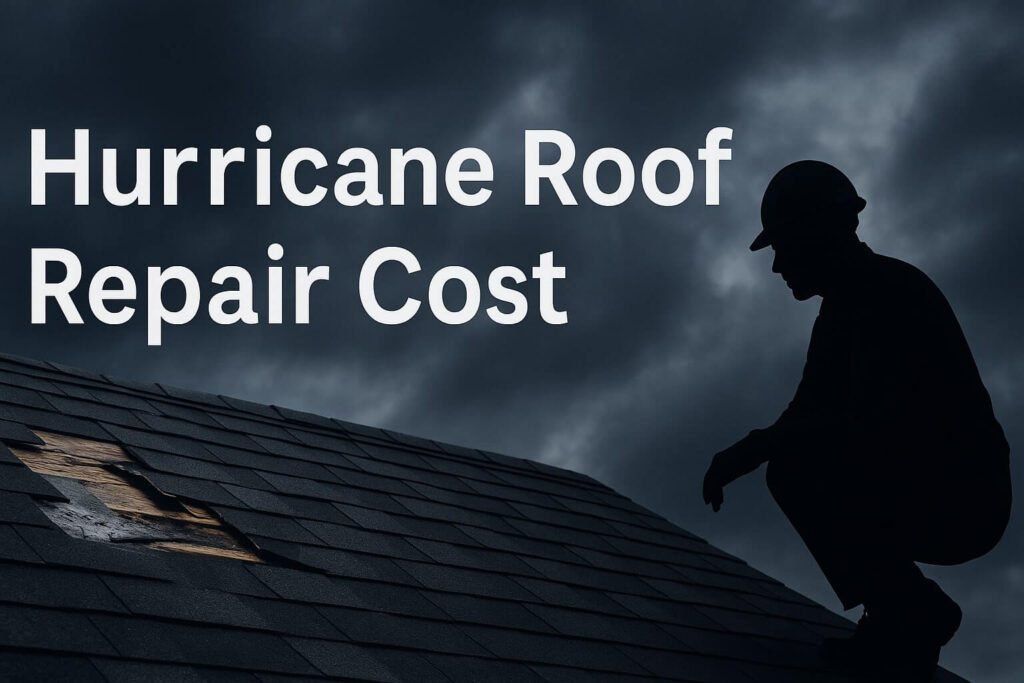If your roof has taken a hit after a hurricane, you’re not alone. Each storm season brings thousands of homeowners face to face with a gut-check question: how much is this going to cost me? Whether it’s a few shingles blown away or full sections ripped open by wind and flying debris, understanding the hurricane roof repair cost ahead of time helps you act faster, smarter, and with fewer regrets.
We’ve all seen it: tarps fluttering in the breeze, neighbors calling out roofers, insurance adjusters roaming the streets. It’s a familiar scene after any major hurricane. But behind the blue tarps and ladder trucks lies a swirl of numbers that can be confusing, frustrating, and—if you’re not prepared—overwhelming. So let’s break down the costs clearly, using the most up-to-date information available, in plain English.
The real cost of hurricane roof repairs
On average, the hurricane roof repair cost ranges between $380 to $1,800 for minor repairs, and anywhere from $5,000 to $15,000+ for major structural damage. These are not extreme cases either. If your roof’s been partially peeled back by a Category 2 wind gust, you’re likely looking at several thousand dollars minimum. In fact, storm-related roof damage across the U.S. averages about $12,378, based on homeowner claims in recent years.
Several factors influence where your costs will land in that range: the size of your roof, its slope or pitch, the material it’s made of, and how extensive the damage is. For example, patching a few shingles on a low-slope asphalt roof will obviously cost much less than replacing 30% of a tile roof on a two-story house with architectural flourishes. Even just accessing the area—say if it’s over a garage, dormer, or a steep gable—can push the labor charges higher.
Let’s talk about materials for a second. Asphalt shingles, the most common type, typically cost $4–$7 per square foot to repair. That’s the base rate. But clay tile roofs can go up to $25 per square foot, and standing seam metal may hit $20 or more, depending on the finish and gauge. If your roof is made from wood shakes, slate, or a custom composite, expect to pay on the premium end of the scale, particularly if matching materials are hard to find after a big storm when supply chains are stretched thin.
Labor rates also play a major role. In high-demand areas like Florida or Louisiana post-storm, certified roofers often charge $50–$150 per hour, especially for emergency jobs. Add in permit fees, scaffolding rentals, or waste disposal—suddenly your moderate damage becomes a four-figure bill fast.
Insurance, deductibles, and out-of-pocket surprises
Now for the question everyone asks: “Is it covered?” In many cases, yes—homeowners insurance usually covers hurricane roof damage caused by wind or falling debris. But there’s a catch. Most policies carry a wind or hurricane deductible, and it’s not a flat number. It’s a percentage, often 2%–5% of your dwelling coverage. For a $300,000 home, that means you’ll be paying $6,000–$15,000 out of pocket before insurance kicks in.
Even trickier, some insurers apply actual cash value (ACV) instead of replacement cost (RCV) to older roofs. That means they depreciate your roof’s value over time, leaving you with a lower reimbursement than you expect. A 20-year-old shingle roof might get valued at 25% of its original cost, even if it’s still functioning well.
If water leaks into your home through a damaged roof and causes mold or structural rot, repairs can spiral well beyond just replacing shingles. And unfortunately, flood damage or storm surge is not covered by most standard policies—that falls under flood insurance, which many homeowners still don’t carry.
That’s why documentation is key. Before storm season, take photos of your roof from multiple angles. After a storm, document damage thoroughly, and get a professional inspection. Many contractors offer free estimates and know how to write reports that match insurer requirements. Don’t rely on a handshake quote scribbled on a napkin.
How to protect your wallet before and after the storm
There’s no way to completely eliminate the cost of hurricane roof repairs. But there are ways to manage it wisely. First, don’t delay. Small roof openings lead to water intrusion, which can double or triple your final costs if left unresolved. Mold remediation, drywall replacement, ceiling repair—it all adds up. Tackling damage early can save thousands.
Second, shop around. Get at least three written estimates from licensed contractors. Make sure they’re local, insured, and experienced in storm repair—not just roofers chasing the storm across states. Ask for photos of past work, references, and what materials they recommend. Some may offer financing or insurance claim assistance as part of their package.
Third, consider upgrades while you’re at it. If you live in a hurricane-prone zone, ask your roofer about reinforcing techniques like hurricane straps, impact-resistant shingles, or sealed roof decks. Yes, these add a bit to the upfront price, but they can reduce your insurance premiums and protect you better in the next storm.
Lastly, consider bundling. If your roof was damaged, chances are your gutters, siding, soffits, or even solar panels took a hit too. Some contractors offer discounts when handling multiple repair jobs at once, saving you on mobilization costs.
Knowing the hurricane roof repair cost landscape puts you in a far better position when disaster strikes. You don’t have to be caught off guard or left scrambling through fine print while rain seeps into your attic. Start with a pre-season roof inspection. Understand your insurance policy in detail. Keep emergency funds or credit ready for the deductible. And when the time comes, work with a local roofer who knows both the weather patterns and building codes in your area.
At the end of the day, your roof is your first line of defense. The more you know about its risks, costs, and options, the more control you’ll have when the skies clear.


